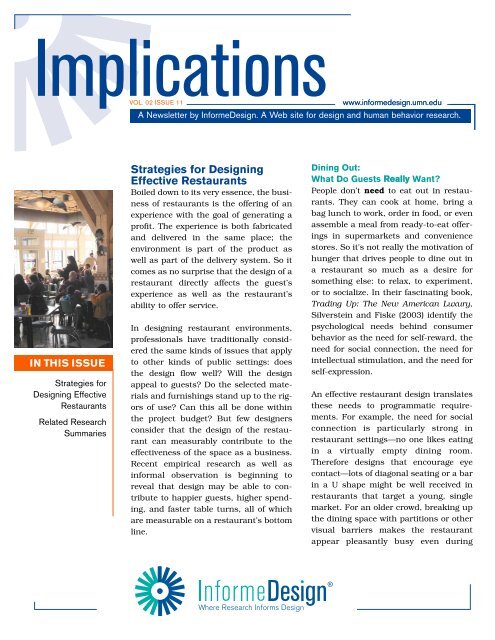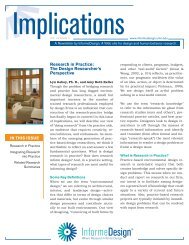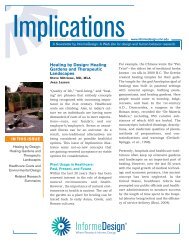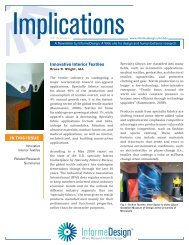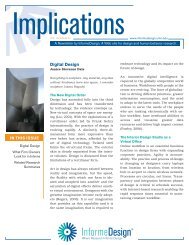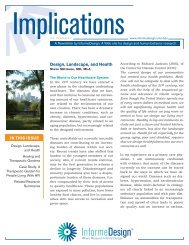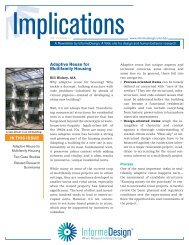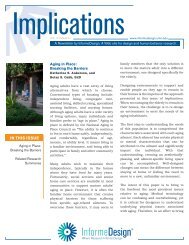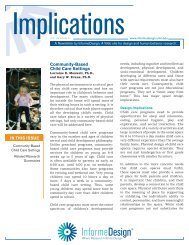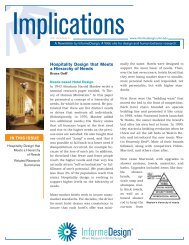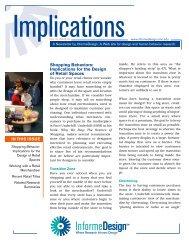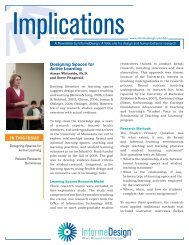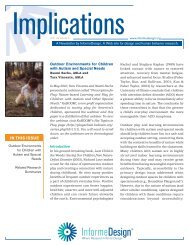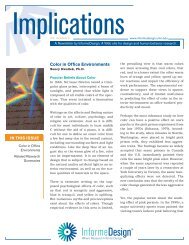Strategies for Designing Effective Restaurants - InformeDesign
Strategies for Designing Effective Restaurants - InformeDesign
Strategies for Designing Effective Restaurants - InformeDesign
You also want an ePaper? Increase the reach of your titles
YUMPU automatically turns print PDFs into web optimized ePapers that Google loves.
Implications<br />
VOL. 02 ISSUE 11<br />
www.in<strong>for</strong>medesign.umn.edu<br />
A Newsletter by In<strong>for</strong>meDesign. A Web site <strong>for</strong> design and human behavior research.<br />
IN THIS ISSUE<br />
<strong>Strategies</strong> <strong>for</strong><br />
<strong>Designing</strong> <strong>Effective</strong><br />
<strong>Restaurants</strong><br />
Related Research<br />
Summaries<br />
<strong>Strategies</strong> <strong>for</strong> <strong>Designing</strong><br />
<strong>Effective</strong> <strong>Restaurants</strong><br />
Boiled down to its very essence, the business<br />
of restaurants is the offering of an<br />
experience with the goal of generating a<br />
profit. The experience is both fabricated<br />
and delivered in the same place; the<br />
environment is part of the product as<br />
well as part of the delivery system. So it<br />
comes as no surprise that the design of a<br />
restaurant directly affects the guest’s<br />
experience as well as the restaurant’s<br />
ability to offer service.<br />
In designing restaurant environments,<br />
professionals have traditionally considered<br />
the same kinds of issues that apply<br />
to other kinds of public settings: does<br />
the design flow well? Will the design<br />
appeal to guests? Do the selected materials<br />
and furnishings stand up to the rigors<br />
of use? Can this all be done within<br />
the project budget? But few designers<br />
consider that the design of the restaurant<br />
can measurably contribute to the<br />
effectiveness of the space as a business.<br />
Recent empirical research as well as<br />
in<strong>for</strong>mal observation is beginning to<br />
reveal that design may be able to contribute<br />
to happier guests, higher spending,<br />
and faster table turns, all of which<br />
are measurable on a restaurant’s bottom<br />
line.<br />
Dining Out:<br />
What Do Guests Really Want?<br />
People don’t need to eat out in restaurants.<br />
They can cook at home, bring a<br />
bag lunch to work, order in food, or even<br />
assemble a meal from ready-to-eat offerings<br />
in supermarkets and convenience<br />
stores. So it's not really the motivation of<br />
hunger that drives people to dine out in<br />
a restaurant so much as a desire <strong>for</strong><br />
something else: to relax, to experiment,<br />
or to socialize. In their fascinating book,<br />
Trading Up: The New American Luxury,<br />
Silverstein and Fiske (2003) identify the<br />
psychological needs behind consumer<br />
behavior as the need <strong>for</strong> self-reward, the<br />
need <strong>for</strong> social connection, the need <strong>for</strong><br />
intellectual stimulation, and the need <strong>for</strong><br />
self-expression.<br />
An effective restaurant design translates<br />
these needs to programmatic requirements.<br />
For example, the need <strong>for</strong> social<br />
connection is particularly strong in<br />
restaurant settings—no one likes eating<br />
in a virtually empty dining room.<br />
There<strong>for</strong>e designs that encourage eye<br />
contact—lots of diagonal seating or a bar<br />
in a U shape might be well received in<br />
restaurants that target a young, single<br />
market. For an older crowd, breaking up<br />
the dining space with partitions or other<br />
visual barriers makes the restaurant<br />
appear pleasantly busy even during
Implications<br />
slower periods, and allows guests to feel connected to<br />
but not necessarily part of a larger group.<br />
The emotional connection we have with a restaurant<br />
also contributes to our desire to eat there and to our<br />
purchasing behavior. Zaltman (2003) suggests that<br />
as much as 95% of a purchasing decision is based on<br />
emotional response rather than rational consideration.<br />
Also, a positive emotional reaction is the<br />
strongest indicator of loyalty to a business. Good<br />
restaurant designers start the creative process by<br />
asking the restaurant owner what kind of emotional<br />
experience is intended <strong>for</strong> the space, and how he or<br />
she wants guests to feel as they leave. If an owner<br />
indicates that the intention is <strong>for</strong> an exciting, transporting<br />
evening of exotic tastes, the design might<br />
include stimulating elements such as high contrast<br />
in colors and textures, dramatic lighting, and tighter<br />
seating placement. Conversely, if the restaurateur<br />
intends the guest to feel nurtured and refreshed, a<br />
very different approach to materials, seating type and<br />
placement, and atmospheric effects might be selected.<br />
Care needs to be taken, however, to ensure that<br />
the design doesn’t become too chaotic or conflict with<br />
the other elements of the experience, namely the food<br />
and the personal service.<br />
You Are Where You Sit<br />
Dissimilar from most settings, full-service restaurants<br />
rarely offer their guests the opportunity to<br />
choose their own seats. This is because restaurant<br />
managers strive to match the party size to available<br />
tables. That way, as many seats as possible are occupied<br />
at any one time and the workload of servers and<br />
the kitchen is balanced. Based on these factors, service<br />
runs smoothly. Thus the hostess does more than<br />
just “greet and seat;” she plays a very important role<br />
in the ongoing success of the business.<br />
But given a choice of where to sit in a restaurant, a<br />
substantial majority of people prefer sitting at a table<br />
www.in<strong>for</strong>medesign.umn.edu<br />
2<br />
next to some kind of permanent architectural feature:<br />
a window, a wall, or even a low partition. This<br />
“anchoring” behavior is most likely related to psychological<br />
needs: we need personal space around us to<br />
feel com<strong>for</strong>table. We try to define and defend our personal<br />
space by using elements of the environment as<br />
well as body position and eye contact to limit opportunities<br />
<strong>for</strong> encroachment. While research has<br />
shown that different cultural groups have different<br />
definitions of how much personal space is desirable,<br />
we have found that restaurant seating preferences<br />
are relatively consistent across multiple cultural<br />
groups.<br />
Food court seating behavior: “anchoring” of patrons to<br />
architectural features.<br />
An interesting, recent study suggests that a more<br />
important indicator of where guests prefer to sit is<br />
the type of dining occasion and the relationship to a<br />
diner's companions. Those surveyed, identified seats<br />
in the window as being most desirable <strong>for</strong> status<br />
occasions: romantic dinners or intimate meals with<br />
friends. However, when the dining occasion involved<br />
a significant difference in status or power between<br />
the participants—such as a job interview over a<br />
meal, seat preferences changed to heavily anchored,<br />
corner tables. And on occasions where diners ate<br />
alone, the strong preference was <strong>for</strong> an anchored<br />
Where Research In<strong>for</strong>ms Design ®
Implications<br />
table in a low-status part of the dining room, near<br />
the front door. It was the rare individual who<br />
expressed any interest in a table that “floated” in the<br />
middle of the room with no anchoring features. While<br />
some published research suggests that females prefer<br />
more heavily anchored locations than men, these<br />
findings are not consistent.<br />
In foodservice operations where guests can seat<br />
themselves, this preference <strong>for</strong> anchored seats is very<br />
apparent to any observer. Diners will select an empty<br />
anchored table first, but if no anchored table is available<br />
will choose an unanchored one that positions<br />
the diner well away from strangers.<br />
Cafeteria seating behavior: selection of preferred seating location.<br />
Only under conditions of extreme crowding—such as<br />
a mall food court at lunch hour, will patrons share a<br />
table, and even then, careful arrangement of parcels<br />
and body language restricts interaction with others.<br />
In light of this, the trend toward “communal tables”<br />
in some fashionable restaurants has fizzled; guest<br />
discom<strong>for</strong>t prevents the restaurant management<br />
from being able to fill all the seats around the table,<br />
defeating one purpose of these communal tables,<br />
which was to put more paying customers in the same<br />
square footage.<br />
www.in<strong>for</strong>medesign.umn.edu<br />
Managing Duration By Design<br />
<strong>Restaurants</strong> don’t really sell food so much as they<br />
sell time; guests are “renting” a dining seat <strong>for</strong> a limited<br />
period, and the rent charged is the money paid<br />
<strong>for</strong> what is consumed. On average, the longer guests<br />
stay at a table, the more they need to be spending <strong>for</strong><br />
the restaurant to maximize its revenues. So it is in<br />
the business’ interest to either encourage a long stay<br />
and try to generate higher revenues at each table, or<br />
to emphasize volume through streamlining the dining<br />
experience. However, noticeably rushing the<br />
guest can backfire, resulting in an unhappy customer<br />
and bad word-of-mouth. <strong>Effective</strong> restaurant<br />
designers work with owners to build in design<br />
approaches that support whichever duration strategy<br />
is selected.<br />
A recent study examined the relationships among<br />
seat features, meal duration, and spending, and<br />
found that guests spent less time at tables that were<br />
less desirable (near the kitchen or in high traffic<br />
areas) but spent just as much money per person as<br />
they did at the average table. Interestingly, anchored<br />
tables in the group studied didn’t per<strong>for</strong>m much differently<br />
from unanchored tables in terms of meal<br />
duration or spending.<br />
3<br />
Duration and location: time and expenditure as influenced by<br />
table quality.<br />
Where Research In<strong>for</strong>ms Design ®
Implications<br />
But when anchored tables were broken down by<br />
type, it was clear that booth seats generated higher<br />
spending on average than did other kinds of<br />
anchored tables, while guests seated at banquettes<br />
stayed longer but didn’t spend as much.<br />
Duration and location: time and dollars expended as determined<br />
by seated location as related to an “anchor.”<br />
Of course, these results were from a single restaurant<br />
and it’s premature to generalize these findings<br />
to all types of foodservice operations. However,<br />
designers might take note of the subtle effects that<br />
seat location may have on restaurant per<strong>for</strong>mance<br />
and plan their seating layouts accordingly.<br />
Other design elements that may affect length of stay<br />
include music and lighting. Work with supermarkets<br />
has shown that up-tempo music at about 120 beats<br />
per minute encourages shorter shopping times, and<br />
one restaurant study saw that faster music can contribute<br />
to faster service. Dramatic sound-and-light<br />
elements built into the restaurant experience were<br />
popular additions to heavily themed restaurants in<br />
the 1980s and 1990s, but observations seem to indicate<br />
that patrons tired quickly of these overly stimulating<br />
features. Whether they contributed to faster<br />
meal duration is open to debate.<br />
www.in<strong>for</strong>medesign.umn.edu<br />
4<br />
Conclusion<br />
There is much more work to be done to measure how<br />
guests respond to specific restaurant design decisions.<br />
However, what is known can be applied with<br />
positive outcomes in terms of supporting the restaurateur’s<br />
mission of creating a viable business and<br />
giving customers a reason to come back. By starting<br />
with a frank discussion with the restaurateur about<br />
the intended guest experience and the profile of the<br />
target market, designers can focus on the customer<br />
and then apply what is known about guest behaviors<br />
to the seating layout and other furnishings, fixtures,<br />
and equipment (F, F, & E) decisions to craft an effective<br />
dining environment that corresponds to the<br />
restaurateur’s goals.<br />
References<br />
—Kimes, S., & Robson, S. (2004). “The Impact of<br />
Restaurant Table Characteristics on Meal<br />
Duration and Spending.” Cornell Hotel and<br />
Restaurant Administration Quarterly, 45(4), 333-<br />
346.<br />
—Robson, S. (2002). “A Review of Psychological and<br />
Cultural Effects on Seating Behavior and Their<br />
Application to Foodservice Settings.” Journal of<br />
Foodservice Business Research, 5(2), 89-107.<br />
—Silverstein, M., & Fiske, N. (2003). Trading Up: The<br />
New American Luxury. Portfolio: New York.<br />
—Underhill, P. (1999). Why We Buy. New York:<br />
Simon & Schuster.<br />
—Zaltman, G. (2003). How Customers Think:<br />
Essential Insights Into the Mind of the Market.<br />
Harvard Business School Press: Cambridge, MA.<br />
Where Research In<strong>for</strong>ms Design ®
Implications<br />
www.in<strong>for</strong>medesign.umn.edu<br />
5<br />
About the Author:<br />
Stephani Robson holds<br />
a Master of Science<br />
degree (1999) in<br />
Human-Environment<br />
Relations from the<br />
Department of Design<br />
and Environmental<br />
Analysis at Cornell. Ms.<br />
Robson is currently on<br />
the faculty at the Hotel<br />
School teaching hotel<br />
and restaurant development<br />
and design courses. Her academic interests<br />
center on how environments affect behavior, with a<br />
particular focus on hospitality settings. Ms. Robson<br />
is actively researching restaurant design psychology,<br />
and has been published in a variety of academic and<br />
industry publications. A native of Vancouver,<br />
Canada, she also has extensive experience as a food<br />
service designer.<br />
Related Research Summaries<br />
In<strong>for</strong>meDesign has many Research Summaries about<br />
restaurant and hospitality design and related, pertinent<br />
topics. This knowledge will be valuable to you<br />
as you consider your next design solution and worth<br />
sharing with your clients and collaborators.<br />
“Increasing Table Turnover in <strong>Restaurants</strong>”—Cornell<br />
Hotel and Restaurant Administration Quarterly<br />
“Restaurant Design and Globalization”<br />
—Journal of Architectural Education<br />
“Restaurant Service Time Preferences”<br />
—International Journal of Hospitality Management<br />
“Increase Diners’ Spending by Adding Features”<br />
—Cornell Hotel and Restaurant Administration<br />
Quarterly<br />
“Selection of Restaurant Location”<br />
—International Journal of Hospitality Management<br />
“Planning Restaurant Seating”—Cornell Hotel and<br />
Restaurant Administration Quarterly<br />
“Creating Customer Loyalty in <strong>Restaurants</strong>”—Cornell<br />
Hotel and Restaurant Administration Quarterly<br />
“<strong>Designing</strong> Hotel <strong>Restaurants</strong> <strong>for</strong> Profitability”—<br />
Cornell Hotel and Restaurant Administration<br />
Quarterly<br />
“Consumer Satisfaction With Restaurant Service”<br />
—Journal of Retailing and Consumer Services<br />
Photos and Graphics Courtesy of:<br />
Caren Martin, University of Minnesota (p. 1)<br />
Stephani Robson, Cornell University (remainder)<br />
The Mission<br />
The Mission of In<strong>for</strong>meDesign is to facilitate interior<br />
designers’ use of current, research-based in<strong>for</strong>mation as<br />
a decision-making tool in the design process, thereby<br />
integrating research and practice.<br />
Created by:<br />
Sponsored by:


